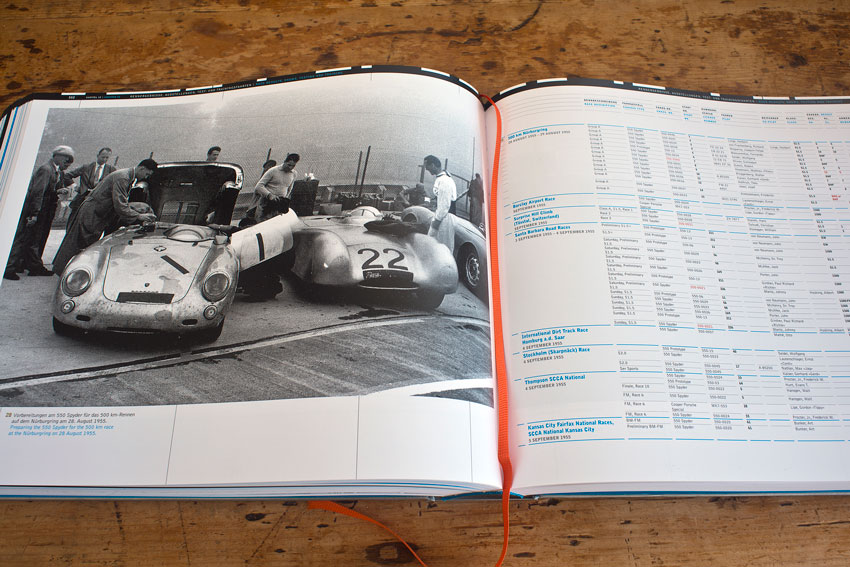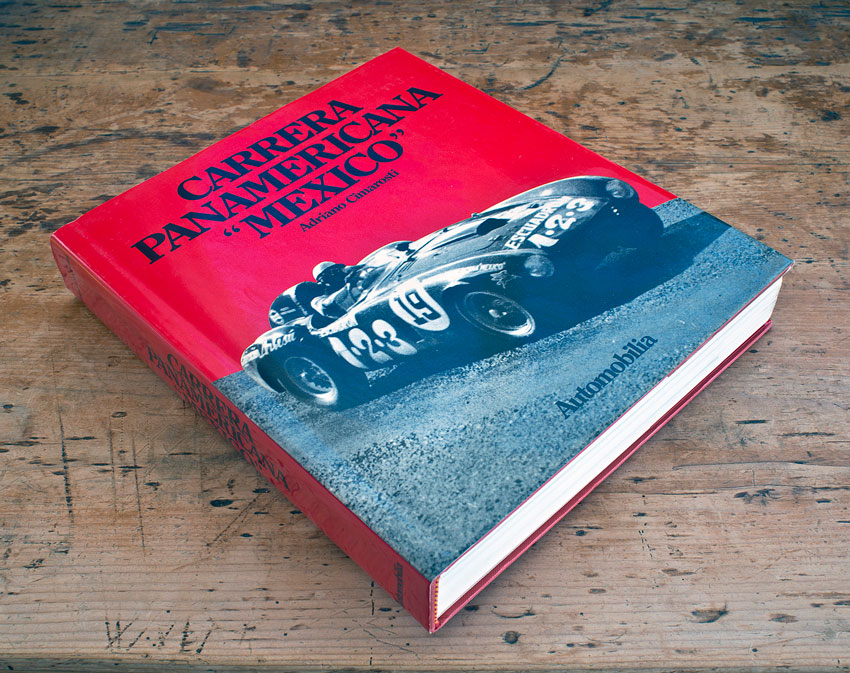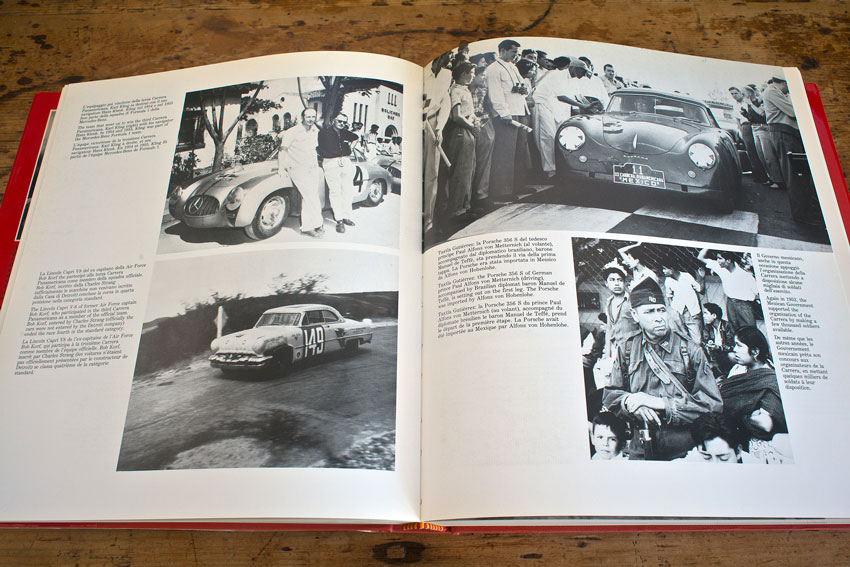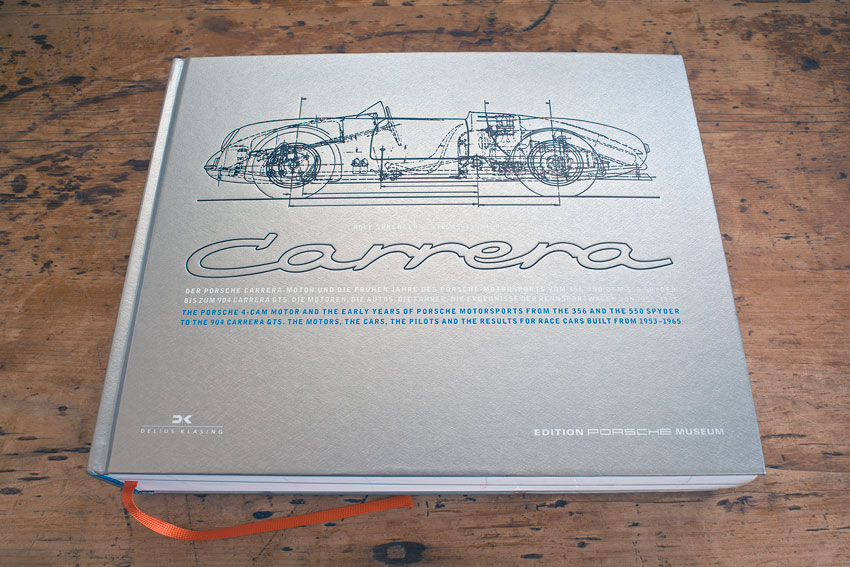Carrera – The Porsche 4-Cam Motor and the Early Years of Porsche Motorsports from the 356 and the 550 Spyder to the 904 Carrera GTS. The Motors, the Cars, the Pilots and the Results for Race Cars Built from 1953 – 1965.
Co-written by Rolf Sprenger and Steve Heinrichs.
This book is going to frustrate some people and make others angry. That’s not because it is massive – at 840 pages at a retail price of $129.99. Its mass, in fact, is part of its success. It will frustrate and anger because for the first time in one place there are facts and dates and numbers for very nearly every Carrera and very nearly all their details and accomplishments. Fabrication of histories to enhance provenance will be much more difficult now.
This is not “just another Porsche book about the Carreras.” Written in English and German, this is an accomplishment that signals other authors to move along, to find another topic. Rolf Sprenger, a Porsche engineer who introduced fuel injection to the 911 and then invented and ran Special Wishes/Exclusive for decades, teamed up with consummate Porsche historian and enthusiast Steve Heinrichs, a man already known for his pretty-much definitive book on Porsche’s Speedsters. Sprenger and Heinrichs spent seven years – and likely every waking minute of those years – researching and preparing this magnum opus. They acknowledge the possibility of mistakes, and, as they wrote, “we have discovered more long-standing controversies than we thought existed.”
They organized this work into ten chapters beginning with a thoughtful profile of the Carrera engine’s inventor Ernst Fuhrmann. From there, the book examines the four variations on the engine, and then the 16 component groups. There are interviews and reminiscences of nine engineers and mechanics who were there during the era these cars competed, followed by a visual reminiscence with 30 pages of racing posters.

Porsche enthusiasts and collectors with a deep understanding of car history will appreciate more what happens from page 352 onward, with 54 pages of build card or Cardex – detail. But that means more than half the book remains to be discovered. Another lovely break occurs with a chapter titled “Cars, Documents and Photos.” From page 472, reading glasses are recommended as section-after-section enumerates spare parts, body color combinations, and statistics. From page 530, Sprenger and Heinrichs bravely venture into the minefield of individual car race histories. This was a massive, even heroic, undertaking as the two historians tackled some 1,545 automobiles. For those easily ensnared by detail, it is completely fascinating to trace the racing careers of such legendary Porsche drivers as Ken Miles, Richie Ginther, and Jack McAfee in the U.S. and Hans Herrmann, Richard von Frankenberg, and Wolfgang von Trips in Germany from chassis to chassis and venue to venue. The entire work is heavily illustrated and while some are familiar images, hundreds of these photos never have been published before this book.
If you own a Porsche with a Carrera engine – or lust after one – this book is the essential reference. If you are fascinated by what many historians and journalists call The Golden Age of Motorsport, you will want it.
Carrera; Rolf Sprenger and Steve Heinrichs. 2014 Delius Klasing & Co. 840 pages. It is available on Amazon: https://www.amazon.com/Porsche-Carrera-Early-Years-Motorsports/dp/3768837505

Carrera Panamericana “Mexico”
Written by Adriano Cimarosti
If you’re interested in learning why Porsche named its racing engine (and then entire cars) after a race on another continent, this hefty 381-page history will answer all your questions. Author Adriano Cimarosti interviewed many of the competitors and their stories put you there, in the pits, in the cars, and alongside the road when they broke down and watched the others roar past. With text and captions written in English, Italian, and French, the very-readable material is thoroughly supplemented by photos from each year and almost every leg. Cimarosti’s information is inside and insightful: “Helmets were mandatory for all, but seatbelts only had to be used in the closed models,” he wrote about the 1952 race…. Seatbelts mandatory? In 1952? That might be the first! “The registration was 5000 pesos per car, equal to 575 dollars. The price money was appetizing: the overall winner of the sports-car category would get 150,000 pesos, while 100,000 would be awarded the winner of the standards.” Appetizing indeed, at $17,250 for winning the sport-car class.

In one particularly moving passage, legendary racer Piero Taruffi relates the story of a crash that killed his friend and three-time winner Felice Bonetto. Taruffi was close enough he nearly collided with Bonetto’s Ferrari during the fatal crash. Such is the intimacy of this incredible work. Another insight came from Quatemalan driver José Herrarte. When he reached Mexico City (in 5th place among 7 survivors in his class) “he considered dropping out because he was exhausted. He pushed through it” and at the finish in Ciudad Juárez, he learned he had won the Small Sports Model class in his 550-02 coupe, #152.
An inserted appendix lists not only the winners by cars and drivers but also chassis numbers. Later pages list the rankings at each of the stages in each year as well as drivers and their stage times. Reading this book and savoring the photos is like time travel to some not-so-far-away land a long, long time ago.
Carrera Panamericana “Mexico”; Adriano Cimarosti. 1987 Automobilia International Publishing Group. 381 pages plus appendix. It is available on Amazon: https://www.amazon.com/Carrera-Panamericana-Mexico-Adriano-Cimarosti/dp/8885058930




